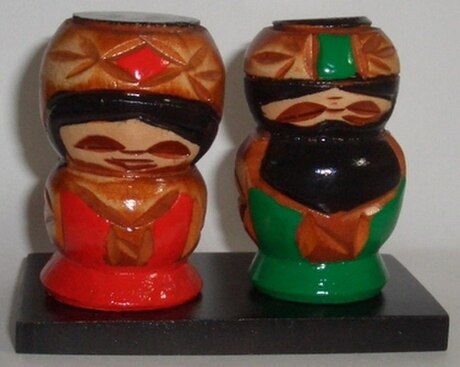Korpokkur (Ainu: コㇿポックㇽ; Japanese: コロポックル, romanized: Koropokkuru),[1] also written Koro-pok-kuru,[2] korobokkuru, korbokkur, or koropokkur,[3] koro-pok-guru, are a race of small people in folklore of the Ainu people of the northern Japanese islands. The name is traditionally analysed as a tripartite compound of kor ("butterbur plant"), pok ("under, below"), and kur ("person") and interpreted to mean "people below the leaves of the Fuki" in the Ainu language.
This article needs additional citations for verification. (November 2011) |

The Ainu believe that the korpokkur were the people who lived in the Ainu land before the Ainu themselves lived there. They were short of stature, agile, and skilled at fishing. They lived in pits with roofs made from butterbur leaves. Long ago, the korpokkur were on good terms with the Ainu, and would send them deer, fish, and other game and exchange goods with them. The little people hated to be seen, however, so they would stealthily make their deliveries under the cover of night.
One day, a young Ainu man decided he wanted to see a korpokkur for himself, so he waited in ambush by the window where their gifts were usually left. When a korpokkur came to place something there, the young man grabbed it by the hand and dragged it inside. It turned out to be a beautiful korpokkur woman, who was so enraged at the young man's rudeness that her people have not been seen since. Their pits, pottery, and stone implements, the Ainu believe, still remain scattered about the landscape.
Anthropologic and Folkloric Discussions
Some anthropologists of the 19th and 20th centuries believed that the korpokkur were in fact a "race that predated the Ainu". Arnold Henry Savage Landor proposed a theory about the indigenous people of Hokkaido, which suggested that the Ainu, migrating from the north, overtook and displaced an earlier population known as the Koro-pok-kuru. He believed the Koro-pok-kuru shared similarities with the Eskimo people and may have arrived in Yezo from the Aleutian Islands.[4][5] Allen P. McCartney equated the Okhotsk culture with the Korpokkur.[6] Early ethnographer Tsuboi Shogoro believed the Koropok-Guru legends pointed to a previous population that the Ainu displaced or even eradicated.[7] These conclusions mostly come from misinterpretations of Hokkaido Jomon artifacts (such as pottery, tools, and arrowheads), which were understudied at the time and markedly different from what contemporaneous Ainu used.
Alexander Akulov[8] refutes early anthropologists, stating that the pit-dwellings supposedly associated with the pre-Ainu aboriginal people were also built by the Ainu themselves in the Kurils and Sakhalin, an argument also used by John Batchelor.[9] Based on the evidence presented, Akulov concludes that the Koropok-Guru legend is nothing more than a story. It does not signify a mysterious pre-Ainu race, but rather reflects a traditional Ainu dwelling practice that predates significant Japanese influence. He cites Pozdneyev, arguing that the legend "was spread there where Ainu were already more or less japanized", quoting:
Further northward the legend has terminated, in the northern Kuril Islands there nobody knows anything about it, and Ainu of Northern Kurils not only tell that the islands were not inhabited by someone else but insisted that they had lived in these islands since very deep antiquity. Being interrogated about the remains of the Stone Age they confidently responded that these remains belong to their ancestors.[10]
In his Ainu–English–Japanese Dictionary, John Batchelor says that certain pit-dwellings associated with the korpokkur were called "Koropok-un-guru koro chisei kot" or "Toi chisei kotcha utara kot chisei kot", respectively meaning "sites belonging to people who dwelt below ground" and "house sites of people who had earth houses." He arguments that the original meaning of Koropok-guru was not "people of the Petasites plant" (Petasites being synonymous with butterbur), since Koropok can only be translated as “under, beneath, below.” The full name would be Koropok-un-guru, “people dwelling below,” un being a locative particle, which doesn't carry the idea of dwarves or little people. He further argues that, even if "Koropok-guru" literally meant "people under the Petasites" plant, it wouldn't imply dwarfish stature. Batchelor himself, standing nearly 5 ft. 8 in., could comfortably walk and even ride a pony amongst the Petasites leaves. He found it humorous to imagine how tall the people who named the pit-dwellers "dwarves" must have been if they considered movement beneath the plant indicative of short stature.[9]
See also
Further reading
- John Batchelor (1904). The Koropok-Guru or pit-dwellers of north Japan, and, A critical examination of the nomenclature of Yezo, Volume 19. Yokohama: Japan Mail. p. 18. Retrieved 1 March 2012. (Harvard University) (digitized Jan 20, 2006)
- Arnold Henry Savage Landor (2001). Alone with the Hairy Ainu or, 3,800 Miles on a Pack Saddle in Yezo and a Cruise to the Kurile Islands. Elibron. ISBN 9781402172656.
References
External links
Wikiwand in your browser!
Seamless Wikipedia browsing. On steroids.
Every time you click a link to Wikipedia, Wiktionary or Wikiquote in your browser's search results, it will show the modern Wikiwand interface.
Wikiwand extension is a five stars, simple, with minimum permission required to keep your browsing private, safe and transparent.
